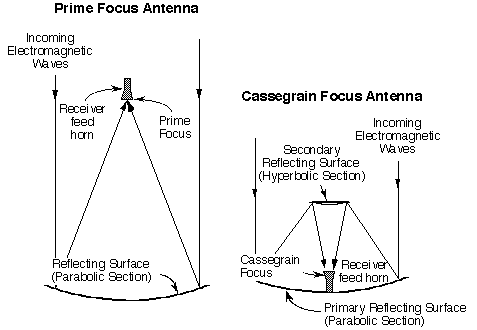Communications SystemHow does NASA communicate with spacecraft? |
This principle of reflection is used to great advantage in antenna design. It is used to focus waves into a narrow beam for transmission, and to collect and concentrate received signals for a receiver.
If a reflector is designed with the surface shaped like a paraboloid, (bowl-shape) electromagnetic waves approaching head-on will be reflected and focus in a central spot above the surface of the reflector where it is collected. This arrangement is called prime focus, and the part of the antenna at the prime focus that takes in the signal is called the feed horn.
A major problem with prime focus arrangement is that it doesn't work well for large antennae. The equipment required at the feed horn on large antennas is heavy and requires a very strong supporting structure. A solution is the Cassegrain Focus arrangement. Cassegrain antennas add a second reflecting surface that send the waves back to a feed horn sitting on or near the main reflector. The DSN's antennas are designed this way because it accommodates their enormous dishes and is still structurally strong.
Aside from these specific designs, antennas may also be categorized by the amount of "gain" they exhibit. These categories range from HGA's (high gain antennas) to LGA's (low gain antennas).
 .
.
Figure from NASA's Jet Propulsion Laboratory's publication: Basics of Space
Flight Learner's Workbook. http://www-b.jpl.nasa.gov/basics/
![]()
How does reflection affect radio waves?
What is the Deep Space Network?
How does NASA run space missions?
![]()
What are high and low gain?
What new communications features is DS1 using?
Why does communication get harder at greater distances?
How is NASA overseeing the DS1 mission?
![]()
![]()